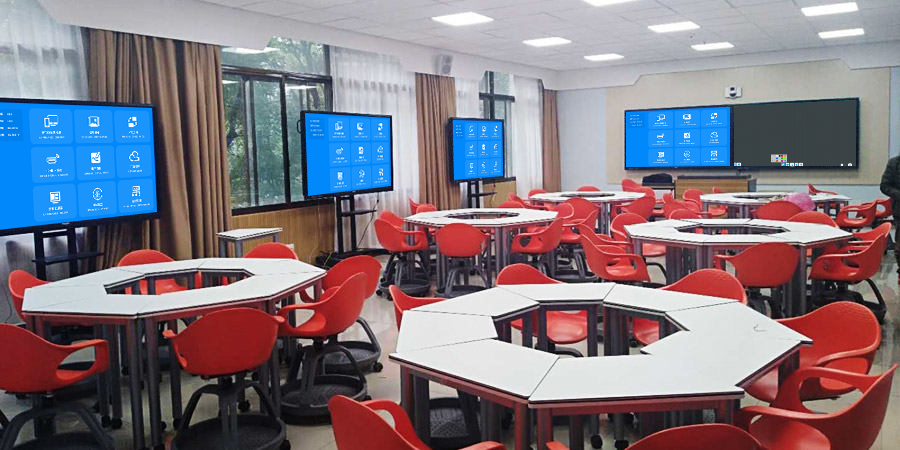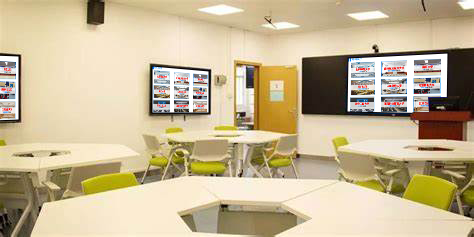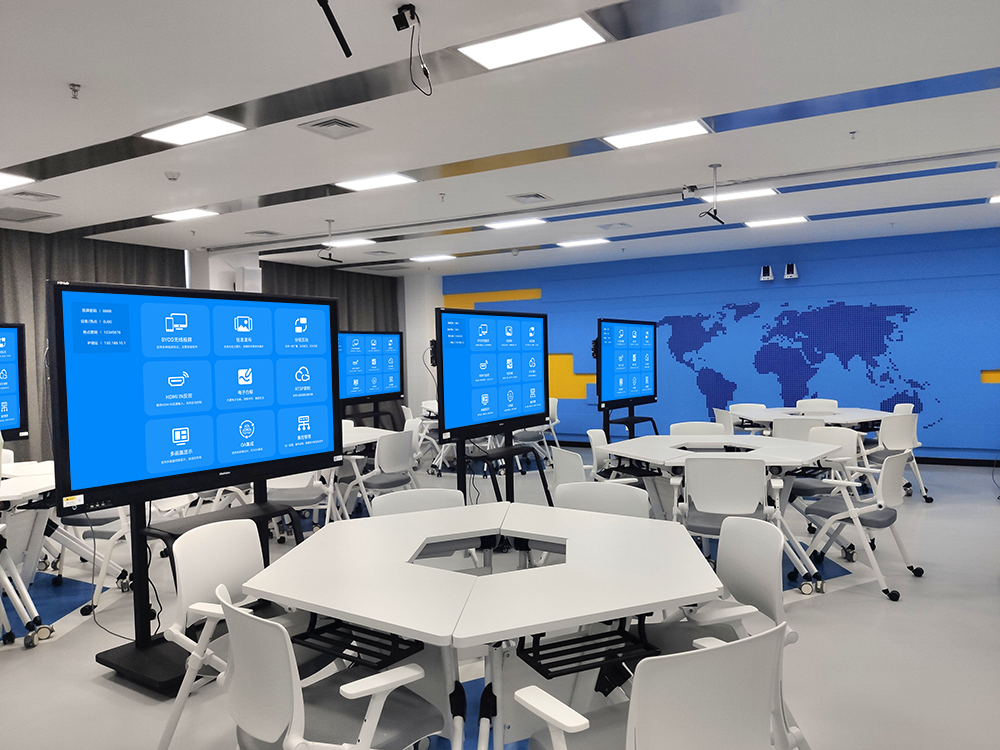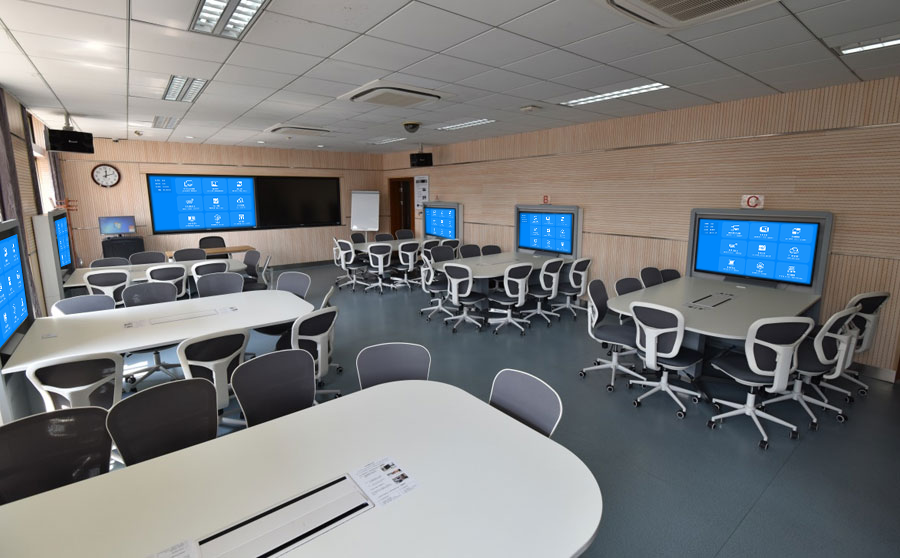Group Discussions: Elevating Collaboration from “Gathering” to “High-Efficiency Co-creation”
In scenarios such as team collaboration, classroom teaching, and project reviews, group discussions are a core method for stimulating diverse thinking and solving complex problems. Traditional group discussions are often limited by “information silos“—difficulty in synchronizing materials within a group, low efficiency in sharing results, and a lack of intuitive comparison during collective reviews. However, a collaboration system specifically designed for group discussions can leverage technology to break down these barriers, allowing each group’s thoughts to flow efficiently and collide effectively.
I. Multi-Screen Linkage: Building a “Star” Information Network
(I) Seamless Integration of Group Screens and Main Screen
Each discussion group is equipped with an independent high-definition screen, forming a “star connection” with the main screen in the classroom or meeting room. During internal group discussions, members can wirelessly mirror content (documents, images, mind maps) from their phones or computers to the group screen, sharing ideas in real-time. When it’s time for a collective presentation, content from the group screen can be “pushed to the main screen” with one click, allowing the entire class or all attendees to view it simultaneously. For example, in a corporate strategy workshop, six departmental groups can outline their proposals on their dedicated screens. The main presenter can then sequentially retrieve each group’s results on the main screen for horizontal comparison and analysis, avoiding the time wasted on “taking turns presenting at the front.“
(II) Material Distribution and Real-Time Synchronization
The organizer can “broadcast” basic materials (e.g., meeting agenda, background data) from the main screen to all group screens, ensuring all groups start from the same baseline. New content generated during group discussions (e.g., hand-drawn sketches, calculation processes) will automatically synchronize to all connected devices within the group, allowing members to view and annotate it on their phones or tablets without crowding around a single screen. In a group discussion for a class of 60 students, the teacher can distribute case materials to 8 group screens with one click, and analytical points annotated by each group in real-time synchronize to members’ devices, boosting collaboration efficiency by 40%.
II. Wireless Screen Mirroring: Making Content Flow Effortless
(I) Cross-Device Full Compatibility
It supports full-terminal screen mirroring from phones (iOS/Android), computers (Windows/macOS), tablets, etc., compatible with all protocols including AirPlay, Miracast, WiDi. If someone in a group captures whiteboard discussion content with an iPhone, another uses a Windows computer for a data table, and a third writes a summary of ideas on an Android tablet, all can quickly project to the group screen via QR code, mirroring code, or NFC tap, without worrying about device brand or system differences. For instance, in a design team discussion, a designer can mirror a design draft from a MacBook, while a client can annotate modification points on an Android phone, with content synchronizing in real-time for more intuitive communication.
(II) Low Latency and High-Definition Transmission
Using dual-band Wi-Fi (2.4G+5G) technology, it ensures 1080P quality screen mirroring with latency ≤ 100ms, and smooth display of 4K content. When discussing complex charts in a group, zoomed-in details remain clear and unblurred. When playing presentation videos, audio and video are synchronized without stuttering. In a medical case study discussion, a group can mirror surgical video clips, allowing members to precisely pinpoint a specific operational detail for discussion, with image clarity comparable to local playback.
III. Interactive Functions: Activating Deep Collaboration
(I) Multi-User Real-Time Annotation and Voting
Group screens support multi-user simultaneous annotation, where different members can use different colored pens to mark key points and raise questions, with annotations displayed in real-time on all connected devices. When discussions reach a deadlock, an in-group vote can be initiated (e.g., “Choosing Solution A/B/C”), with results instantly tallied and displayed, quickly building consensus. For example, when a market research group analyzes user feedback, members can annotate key information on mirrored survey data and vote to identify core needs, avoiding unproductive arguments.
(II) Content Integration and Comparison
It supports “spliced screen mirroring” of content from multiple devices within a group, such as displaying user personas on the left and solutions on the right, for a more intuitive horizontal comparison. In a corporate product iteration workshop, a group can simultaneously mirror “current feature pain points,” “competitor advantages,” and “new feature sketches,” performing correlational analysis on the same screen, boosting creativity generation efficiency by 50%.

IV. Data Accumulation: Making Discussion Outcomes Reusable
(I) Process Recording and One-Click Export
The system automatically records mirrored content, annotation traces, and voting results from group discussions, supporting export in PDF or video formats. After a project discussion, the group can quickly generate a “discussion report,” including animated annotation processes, for easy reporting to management or archiving for review. In school classrooms, exported group results can be added to the teaching resource library for other classes to reference.
(II) Permission Control and Order Maintenance
The organizer can set “group screen permissions,” such as prohibiting unrelated devices from mirroring or restricting the annotation function for temporary visitors, ensuring discussion order. In group discussions at large forums, only registered members might be allowed to mirror to avoid irrelevant information interference. During classroom discussions, a teacher can remotely lock the annotation function of a specific group screen, reminding them to stay focused on the topic.
V. Scenario Implementation: Covering All Collaboration Needs
(I) Corporate Team Discussions
In new product initiation meetings, marketing, technical, and design teams can discuss in subgroups. Through multi-screen linkage, they synchronize requirements, pain points, and proposals, finally consolidating and comparing them on the main screen to accelerate decision-making. In cross-departmental collaboration, remote teams can participate in real-time discussions via group screens, with mirrored content synchronized with local members, eliminating geographical barriers.
(II) Classroom Group Learning
In K-12 project-based learning, a group of 6 students collaborating on an “environmental solution” can divide tasks on their dedicated screen: some research data, some draw flowcharts, and some write action suggestions. Once their results are pushed to the main screen, the entire class can review and add comments, fostering student teamwork and expression skills. In university seminars, graduate student groups can use the annotation function to mark revisions on initial drafts of their papers. After a mirrored discussion, they can export a revised version with one click, far more efficient than traditional “circulating paper drafts.“
(III) Training and Workshops
In a leadership training workshop, participants can complete “case simulations” in groups, displaying their decision-making process via mirroring. The instructor can then review each group on the main screen, using annotation features to highlight key behaviors. In a design workshop, cross-disciplinary groups (product, design, development) can use spliced mirroring to integrate ideas from each stage, quickly outputting feasible solutions.
The core value of group discussions lies in realizing the “1+1>2” effect of collaboration. It breaks down information barriers through multi-screen linkage, lowers the threshold for content flow through wireless screen mirroring, and activates brainstorming through interactive functions. Ultimately, it allows each member’s wisdom to be seen, integrated, and reused. Here, grouping is no longer just “simple personnel division” but the smallest unit of high-efficiency co-creation, providing a clear collaborative path for solving complex problems.